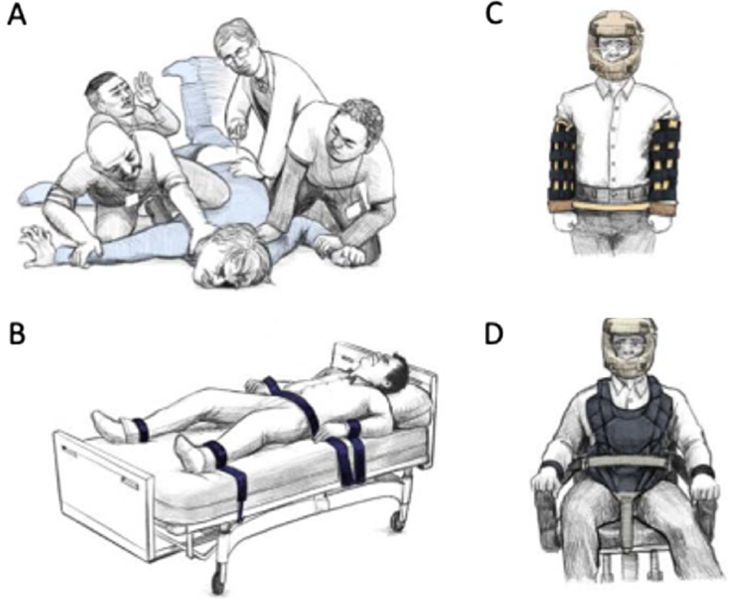A nurse is caring for a client who is in physical restraints. Which of the following actions by the client indicates the restraints can be discontinued?
The client apologizes for their prior behavior.
The client remains in control of their actions.
The client asks to be released from the restraints.
The client signs a behavioral contract.
The Correct Answer is B
Choice A reason:
An apology from the client for their prior behavior, while it may be a positive step towards recovery, does not necessarily indicate that they have regained control over their actions or that they no longer pose a risk to themselves or others. The decision to discontinue restraints should be based on current behavior and risk assessment rather than past actions.
Choice B reason:
The primary goal of using physical restraints is to prevent harm to the patient or others when less restrictive interventions are not effective. If the client demonstrates control over their actions, it suggests that they are no longer at immediate risk of harm, and therefore, discontinuing restraints could be considered³⁴⁵. This aligns with guidelines that advocate for restraint use to be continually assessed and reduced or discontinued as soon as possible.
Choice C reason:
While a request to be released from restraints indicates a desire for freedom, it does not provide enough information about the client's current mental state or risk of harm. The healthcare team must assess whether the client's condition has improved to a point where restraints are no longer necessary.
Choice D reason:
Signing a behavioral contract is a positive step towards establishing trust and setting expectations for behavior. However, it is not an immediate indication that the client can safely have restraints removed. The effectiveness of such contracts depends on the individual's ability to understand and adhere to the agreed-upon behaviors.

Nursing Test Bank
Naxlex Comprehensive Predictor Exams
Related Questions
Correct Answer is B
Explanation
Choice A reason:
Urinary retention is not commonly associated with citalopram. Citalopram, an SSRI (Selective Serotonin Reuptake Inhibitor), primarily affects serotonin levels in the brain and does not typically impact the urinary system to the extent of causing retention.
Choice B reason:
Decreased libido is a known adverse effect of citalopram. SSRIs, including citalopram, can affect sexual function, leading to decreased libido, difficulty achieving orgasm, or erectile dysfunction. This is due to the increased serotonin levels which can negatively impact the sexual response cycle.
Choice C reason:
While bruising is not a hallmark side effect of citalopram, it can occur, especially if there is an interaction with other medications that affect blood clotting. Citalopram can potentially increase the risk of bleeding, and easy bruising may be a sign of this. However, it is less common than other side effects like sexual dysfunction.
Choice D reason:
Jaundice is not a typical adverse effect of citalopram. Jaundice usually indicates a problem with the liver, and while liver function abnormalities have been reported with citalopram use, they are rare. Monitoring for jaundice is not part of the routine assessment for patients on citalopram unless there is a pre-existing liver condition or concurrent use of other hepatotoxic drugs.
Correct Answer is D
Explanation
Choice A reason: A client who is experiencing stimulant withdrawal may exhibit symptoms such as fatigue, depression, and increased appetite. While these symptoms can be distressing, they do not typically include seizures. Stimulant withdrawal does not usually necessitate seizure precautions because the risk of seizures is low.
Choice B reason: A client who is experiencing opioid withdrawal may suffer from symptoms like anxiety, muscle aches, sweating, and nausea. Although opioid withdrawal can be very uncomfortable and distressing, it is not commonly associated with seizures. Therefore, seizure precautions are generally not required for opioid withdrawal.
Choice C reason: A client who is experiencing cannabis withdrawal might experience irritability, sleep disturbances, and decreased appetite. Cannabis withdrawal is not typically associated with seizures, so seizure precautions are not necessary for these clients.
Choice D reason: A client who is experiencing alcohol withdrawal is at a significant risk for seizures. Alcohol withdrawal can lead to severe complications such as delirium tremens, which includes symptoms like confusion, hallucinations, and seizures. Implementing seizure precautions for clients undergoing alcohol withdrawal is crucial to prevent injury and manage potential seizures effectively.
Whether you are a student looking to ace your exams or a practicing nurse seeking to enhance your expertise , our nursing education contents will empower you with the confidence and competence to make a difference in the lives of patients and become a respected leader in the healthcare field.
Visit Naxlex, invest in your future and unlock endless possibilities with our unparalleled nursing education contents today
Report Wrong Answer on the Current Question
Do you disagree with the answer? If yes, what is your expected answer? Explain.
Kindly be descriptive with the issue you are facing.
